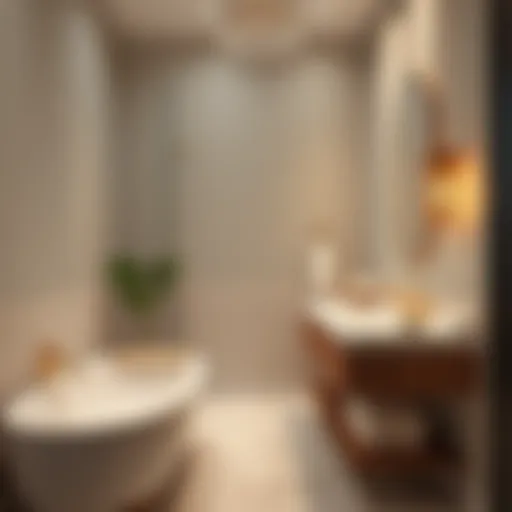Ultimate Guide to Bathroom Remodeling in Ontario, CA
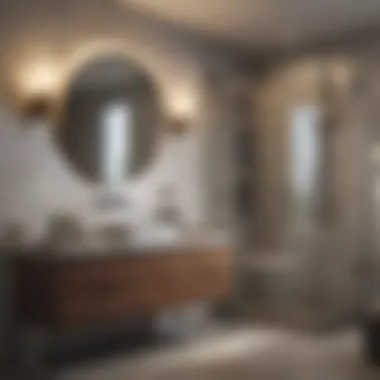

Intro
Bathroom remodeling can be a daunting task, especially in a place as bustling as Ontario, CA. There's no shortage of challenges that homeowners face when embarking on such a project. From selecting the right materials to deciding on an aesthetic that reflects personal style, every choice counts. In this guide, we will navigate through the various aspects of renovation, ensuring that your dream bathroom isn't just a mirage.
Understanding the current trends can ease the planning stage. By having a finger on the pulse of design and functional trends specific to Ontario, homeowners can be better prepared to enhance their spaces. Additionally, practical tips and techniques will help in budgeting and selecting reliable contractors—all crucial for smooth sailing in this transformational journey.
Whether you're a seasoned remodeler or diving into this for the first time, this guide aims to demystify the entire process. We will cover essential considerations like color palettes and styles, ways to visualize your ideas through before-and-after transformations, and valuable insights into avoiding common pitfalls.
It's time to roll up your sleeves and dive into the world of bathroom remodeling!
Understanding Bathroom Remodeling
Bathroom remodeling is not just about changing tiles or adding new fixtures; it's about creating a space that meets your needs and reflects your personal style. Often considered a sanctuary, the bathroom should be functional while also offering a touch of elegance. Knowing the intricacies of this process can make a world of difference in your home renovation journey.
Defining the Scope of Your Project
Before diving in, it’s crucial to define what your project will entail. Are you looking to do a complete overhaul or just update a few elements? If you aim for a minor refurbishing, this might include simply changing the showerhead, vanities, or paint colors. However, a full-blown remodel could engage changing the layout, plumbing, or electrical systems, in which case the project’s scale increases significantly.
It’s important to ask yourself several key questions:
- What do I want to achieve with this remodel?
- How long do I intend to stay in this home?
- Am I looking to increase my property value?
Being clear about the scope can help in planning and budgeting effectively, preventing costly changes midway through the project.
Importance of Remodeling
The importance of remodeling can’t be overstated. A well-executed bathroom remodel can yield a high return on investment. Not only does it enhance the home's aesthetic appeal, but also its functionality. Homeowners often overlook the fact that a bathroom remodel can significantly boost a property’s marketability. If you ever decide to sell, well-maintained, updated bathrooms can make or break a sale.
Moreover, consider the comfort and convenience aspects. Older bathrooms may not accommodate accessibility needs or modern appliances, which can lead to frustration in daily routines. An updated bath ensures not just beauty, but a space that serves your lifestyle effectively.
Even small changes can result in a more enjoyable experience. Changing outdated lighting or adding storage can transform how the area feels and performs.
"Renovation isn’t always about achieving glamour but rather about functionality and overall harmony in a space."
In summary, embracing bathroom remodeling is about enhancing a space that is often used but can feel neglected. With thoughtful planning and execution, you can create an oasis that you and your family will cherish for years to come.
Planning Your Bathroom Remodel
When it comes to remodelling a bathroom, planning is the backbone of a successful project. A well-organized approach not only smooths the process but also maximizes potential benefits, making it essential for any homeowner looking to breathe new life into their space.
Setting a Realistic Budget
Creating a budget is like drawing the map before a journey; it helps guide where you’ll go and how far you can stretch. To kickstart this, gather estimates for materials, labor, and unexpected costs. Think about factors such as:
- Materials: Tiles, vanities, bathtubs; quality can drive prices up, so pick wisely.
- Labor Costs: If you're hiring professionals, gauge different contractor fees in Ontario to avoid surprises later.
- Contingency Funds: Always set aside extra, about 10-20%, for those pesky little surprises. It’s like insurance for your project!
Knowing where to allocate funds lets homeowners pick and choose where to splurge and where to save. For example, a high-end faucet might go well with more budget-friendly tiles. Flexibility here can greatly enhance the outcome without breaking the bank.
Establishing a Timeline
Setting a timeline is equally important. Without one, a project can drag on like molasses in winter. Consider the following:
- Planning Phase: This includes designing, gathering materials, and deciding on contractors. Expect this to take a few weeks.
- Demolition and Construction: If you aim to overhaul the space, set aside a month or more, depending on complexity.
- Final Touches: Expect some days for minor adjustments, painting, and installing fixtures.
Being realistic about how long each phase will take helps manage expectations and keeps everyone involved on the same page. It also minimizes the risk of hasty decisions for quicker results, which can lead to regrets later.
Design Inspirations and Themes
Choosing a theme can turn a mundane bathroom into a personal oasis. Homeowners might find inspiration from various sources:
- Nature-Inspired Decor: Think earthy tones and textures that create a calming atmosphere. Using natural stone can do wonders in this regard.
- Sleek Modern Designs: If minimalism speaks to you, consider streamlined vanities and integrated lighting to give a fresh, tidy look.
- Vintage Touches: Incorporate antique lighting fixtures or claw-foot tubs to add character and warmth.
To explore the ideas further, take a stroll through platforms like Pinterest or visit local showrooms in Ontario for hands-on inspiration. It’s about capturing a feeling in your renovated space—whether that’s tranquility, luxury, or nostalgia.
In the planning stage, these design choices not only reflect personal style but also can influence future resale value. More unique inspirations often lead to standout features that appeal to potential buyers.
Popular Design Trends in Ontario
Understanding the popular design trends in Ontario helps homeowners make informed choices that resonate with current aesthetics while boosting the functionality of their spaces. In recent years, a blend of modern sensibilities and classic elements has taken center stage in bathroom remodeling. These trends not only enhance the beauty of spaces but also influence the overall feel and value of the home. It's essential to look at these design trends through a lens that balances personal taste, practicality, and the surrounding environment.
Modern Aesthetics
Minimalism
Minimalism has carved a niche for itself in bathroom design. It revolves around the concept of "less is more," encouraging homeowners to simplify their spaces by eliminating unnecessary clutter. This approach is not just visually appealing; it significantly enhances the functionality of a bathroom by creating a serene and peaceful environment.
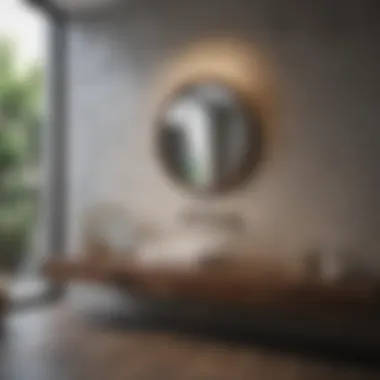

A key characteristic of minimalism is the focus on clean lines and open spaces. It often utilizes neutral colors and natural materials to create a calming atmosphere. One unique feature of minimalist design is its emphasis on utility without sacrificing style. For instance, choosing a sleek, wall-mounted vanity not only saves space but also provides an elegant look.
The advantages of minimalism are ample – it’s easy to maintain and often includes eco-friendly options. However, homeowners must realize that going too stark can make the space feel uninviting, so it's important to strike a balance between simplicity and warmth.
Neutral Palettes
Neutral palettes offer another strong choice for bathroom remodeling. Soft beiges, warm grays, and crisp whites create a backdrop that allows other design elements to shine. This color scheme contributes to a sophisticated ambiance while enabling flexibility in incorporating accessories and fixtures without overwhelming the senses.
The most appealing aspect of neutral palettes is their versatility; they harmonize well with various styles, whether contemporary or traditional. A unique feature of these color schemes is their capacity to make a small space appear larger, which is particularly advantageous in bathrooms with limited square footage.
Advantages here include timelessness and compatibility with numerous decor styles, allowing homeowners to rotate accents as tastes change. However, if not carefully executed, an all-neutral space can sometimes come off as bland or lacking character, emphasizing the importance of thoughtful accent choices.
Classic and Timeless Designs
The classic and timeless designs appeal to those who appreciate enduring styles over fleeting trends. If you’re aiming for elegance that stands the test of time, these designs provide a solid foundation for your bathroom.
Vintage Fixtures
Vintage fixtures bring a sense of nostalgia and charm to bathroom spaces. These pieces often feature ornate designs and rich finishes that can be focal points in a room. Their contribution to the overall renovation lies in their ability to evoke a sense of history while providing practical functionality.
One notable quality of vintage fixtures is their craftsmanship; many are made of durable materials that can withstand wear and tear over time. This characteristic makes them not only a stylish choice but also a sensible investment for homeowners looking for longevity in their remodels. However, sourcing genuine vintage items can sometimes be tricky, and maintenance may require additional effort due to wear.
Traditional Layouts
Traditional layouts are another favored design aspect that prioritize symmetry and formality. These layouts often incorporate classic features like pedestal sinks, clawfoot tubs, and wainscoting, contributing to a cohesive and inviting atmosphere. They encourage a more structured use of space that appeals to those with a taste for the classic.
One key characteristic is their ability to provide a sense of familiarity and comfort; these designs feel lived-in and warm. The uniqueness lies in how traditional layouts can reflect personal style while maintaining functionality. However, it’s important to consider that this approach may require more space than minimalist options, so planning is crucial.
Essential Considerations for Remodeling
When undertaking a bathroom remodel, certain foundational elements must be taken into account to ensure a successful outcome. This section delves into essential considerations that can make or break your renovation project, addressing not just the aesthetic goals but also the functional aspects.
Assessing the Space
Before diving headfirst into any design choices, assessing the available space offers a clear beginning point. Take a step back and look around. What are the dimensions of your bathroom? Are there any architectural features—like windows, doors, or built-in shelves—that you need to work with or around?
Measuring the space provides insight into what’s feasable. If it’s a small powder room, you may want to opt for more compact fixtures instead of sprawling vanities. Alternatively, if you’re blessed with a larger area, consider how you can make the space more inviting by perhaps integrating some natural light through strategic window placements.
Plumbing and Electrical Considerations
Next up, plumbing and electrical considerations play an indispensable role in remodeling. These aren’t the glitzy aspects of your bathroom renovation but critical elements you cannot afford to overlook.
It’s wise to consult a professional if you plan to alter plumbing lines or the electrical layout. Unwittingly placing an outlet in the wrong spot can lead to safety issues or code violations. Also, new fixtures like heated flooring or fancy lighting may require updates to your existing electrical system, ensuring that everything is up to par for your new setup.
Selecting Materials
Choosing the right materials for your remodel is akin to selecting the ingredients for a gourmet meal. Each element contributes to the overall flavor and presentation.
Flooring Options
When it comes to flooring, options abound, but each has specific advantages. Tile flooring is often a top contender due to its durability and resistance to moisture. Another popular choice is luxury vinyl tiles, which mimic the look of wood or stone without the hefty price tag.
If you’re going for a warm, inviting feel, consider cork. This unique flooring option not only feels soft underfoot but also offers natural thermal insulation, making it a popular choice for those who appreciate comfort without compromising style.
Countertops
Countertops are more than just a functional surface; they’re a focal point in your bathroom. Quartz, for instance, has gained numerous points in popularity due to its non-porous nature, making it easy to clean and maintain. It also comes in a variety of colors and patterns, fitting any decor style.
On the flip side, natural stone like marble adds a layer of elegance that many find irresistible. However, it requires more maintenance as it is susceptible to staining and requires regular sealing. Weigh the trade-offs of each carefully when making your selection.
Cabinetry Choices
Cabinets not only provide practical storage solutions but also enhance the aesthetics of your bathroom. Solid wood options add richness and sturdiness, though they may come at a higher cost compared to laminate or MDF alternatives. Manufacturers are crafting more eco-friendly cabinet options that retain style while being good for the planet.
Additionally, consider the layout of your cabinetry. A floating vanity can give the illusion of more space, while a traditional style may work better in a classic-themed room. Explore various styles that can blend harmoniously with your design vision.
"Choosing the right materials can elevate your bathroom from mundane to magnificent, making it a restful retreat rather than just a functional space."
Keeping these essential considerations in mind will ensure your bathroom renovation is not just a surface-level improvement but a thoughtful transformation for years to come.
Finding Quality Contractors
When embarking on a bathroom remodeling journey, finding the right contractor can spell the difference between a successful project and a headache you wish you could flush down the toilet. Quality contractors bring not only skilled craftsmanship but also peace of mind. They help navigate challenges that could arise, such as unexpected plumbing issues or design modifications. You wouldn’t want to put your home in the hands of just anyone, right? Here are some strategies to ensure your base is covered.
Researching Local Services
Before selecting a contractor, it��’s wise to cast a wide net. Start by researching local services. Look for contractors with solid reputations in the Ontario area. An initial search online can yield plenty of names, but don’t just go with the first one on the list. Check out reviews on platforms like Yelp or Angie's List. Ask friends or family if there are any trusted contractors they might recommend. And keep an eye out for any red flags; a contractor with consistently poor reviews should raise a few eyebrows.
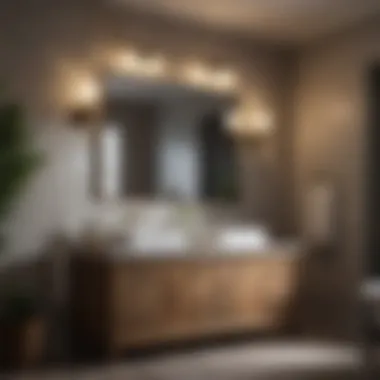

Additionally, local social media groups, such as those on Facebook, often feature discussions where you can solicit suggestions from residents who’ve undergone remodeling themselves. It’s like gathering your own personal panel of experts.
Evaluating Portfolios
Once you’ve narrowed down your list, it’s time to dive deeper. Request portfolios from potential contractors to get a feel for their work. A good portfolio will showcase a variety of styles – after all, bathrooms can range from sleek and modern to cozy and rustic.
While perusing these portfolios, look out for:
- Diversity in Designs: This demonstrates adaptability to different client needs.
- Attention to Detail: Notice the quality of workmanship in the finishes and fittings.
- Before and After Shots: This can give insight into their ability to transform spaces.
Engaging with the contractor about their past projects can also illuminate their problem-solving skills. Ask them about challenges they faced and how they addressed them, which gives you a better idea of what to expect during your own project.
Obtaining Quotes and Proposals
Finally, once you’ve settled on a few candidates, it’s crucial to obtain detailed quotes and proposals. Each quote should cover material costs, labor charges, and timelines. Comparing these estimates can be an eye-opener, showcasing differences in pricing and approach.
A trustworthy contractor will be transparent in their proposal. Make sure to seek clarity on:
- Scope of Work: What exactly is included in the price?
- Payment Terms: When will payments be due, and what are the acceptable methods?
- Project Timeline: How long will it actually take?
It’s essential to avoid selecting a contractor based solely on the lowest quote. Instead, consider the overall value they bring to the table. Remember, you might be saving a few bucks in upfront costs, but if the job isn't done well, you’ll likely spend threefold fixing mistakes down the road. That’s just not worth it.
"Choosing the right contractor is as critical as the materials you select for your remodel. It lays the foundation upon which your entire project stands."
In the end, the goal is to find a contractor who respects your vision while providing their expertise to elevate the quality of your bathroom. Investing time in this selection process will pay off, ensuring a smooth remodeling experience and a finished product that you can take pride in.
DIY vs. Professional Remodeling
Deciding whether to tackle your bathroom remodel as a do-it-yourself (DIY) project or to leave it to the professionals can stir a fair bit of head-scratching. This choice is pivotal and can significantly influence not only the outcome of your renovation but also your budget and stress levels. Both paths come with their own sets of benefits and considerations. Let's peel back the layers and explore what each option entails so you can make an informed decision as you dive into this transformation.
Pros and Cons of DIY
Embarking on a DIY bathroom remodel can be an alluring option for many homeowners. Here’s a look at some of the benefits and drawbacks you might face:
Pros
- Cost Savings: One of the biggest draws for DIY is saving on labor costs. With the right skills, you can pocket those extra bucks.
- Creative Control: When doing it yourself, you have full control over every little detail. Want that quirky cabinet color? Go for it! Your bathroom can genuinely reflect your personality.
- Flexibility: You work on your schedule, allowing you to patch up the bathroom when it suits you, rather than coordinating with a contractor’s timeline.
Cons
- Skill Level: Not everyone has the handyman savvy to take on plumbing or electrical work. Cutting corners here could lead to costly mistakes.
- Time-Consuming: You might think you’ll finish it in a weekend, but remodels often take longer than expected. The reality of juggling day-to-day life may stretch timelines.
- Stress: Managing everything, from sourcing materials to doing the work, can be overwhelming and time-consuming.
When to Hire Professionals
There are certainly times when enlisting a pro makes sense. Knowing when to hire professionals can save you from a world of headaches. Here are some conditions that might lead you to ring up a contractor:
- Complex Projects: If your remodel involves significant structural changes or moving plumbing and electrical wires, it’s best to leave it to the experts. These complexities require skilled hands and often local permits.
- Specific Design Needs: If you dream of a cutting-edge design that requires specialized skills and tools, like custom cabinetry or intricate tile work, a professional can bring a level of craftsmanship that may be hard to replicate on your own.
- Time Constraints: If you’re balancing work, family, and life—or just don’t have the time to dive into a detailed remodel—hiring a contractor can expedite the process and take the burden off your shoulders.
Remember, embarking on a bathroom remodel is not just about aesthetics; it's about creating a functional space that meets your family's needs. Weighing the pros and cons of DIY versus professional help becomes essential to ensure you’re making a choice that aligns with your goals and circumstances.
"In remodeling, knowing your strengths and limitations is half the battle. Make the right choice and you’ll enjoy the process even more."
In the end, whether you decide to roll up your sleeves and get your hands dirty or allow a professional to weave their magic, the right approach depends on your unique situation, skills, and vision for your ideal bathroom.
Sustainability in Bathroom Remodeling
Sustainability in bathroom remodeling is not just a trend; it's becoming a necessity for many homeowners in Ontario, CA. With the ongoing conversations about climate change and environmental preservation, incorporating sustainable practices into your renovation can yield significant benefits for both the planet and your home's value. By focusing on eco-friendly choices in materials, fixtures, and technologies, not only can you create a stylish space, but you can also contribute to a healthier environment and potentially save on utility bills.
Being mindful of our choices today can lead to a greener tomorrow.
Eco-Friendly Materials
When selecting materials for your bathroom remodel, aim for products that have minimal impact on the environment. Think about sustainable sources. For example, bamboo is an excellent alternative to traditional wood, as it grows quickly and doesn't require harmful pesticides.
Additionally, reclaimed materials can add character to your space while reducing waste—salvaged wood for cabinetry or old bricks for accents can provide a unique touch.
Another consideration is low-VOC (volatile organic compounds) paints and sealants. They release fewer toxins into the air, improving indoor air quality significantly. It's a small adjustment that can make a huge difference, particularly in enclosed areas like bathrooms.
Water-Saving Fixtures
Water conservation is a critical aspect of sustainability in bathroom remodeling. Installing water-saving fixtures can make a noticeable impact on your water bills and the overall ecological footprint of your home. Options such as low-flow toilets, faucets, and showerheads are readily available.
Low-flow toilets, for instance, use about 1.6 gallons per flush, compared to older models that can consume up to 7 gallons. Not only is this a much greener choice, but it also gives your bathroom a modern edge.
Showerheads that limit water flow without sacrificing pressure are popular among homeowners looking to save water without losing comfort.
Additionally, consider adding a rainwater collection system. While it may seem excessive, it can be a valuable long-term investment for eco-conscious homeowners looking to integrate nature into their urban living.
Energy-Efficient Lighting Solutions
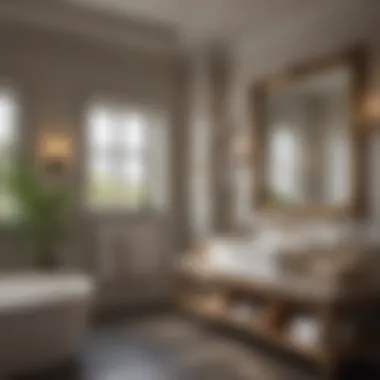

Lighting plays a significant role in energy consumption within your bathroom. Opting for energy-efficient lighting not only reduces your energy bills but also enhances the overall ambiance. LED lights are a must; they consume less energy and have a longer lifespan compared to traditional bulbs.
Incorporating natural light, when possible, is another excellent avenue. Skylights or strategically placed windows can illuminate the space during the day, minimizing the need for artificial lighting at all.
You might also want to consider smart lighting solutions that adapt to your schedule. Motion sensors can ensure lights are only on when needed, providing both convenience and energy savings.
By integrating these sustainable options, you're not merely making aesthetic improvements; you're creating a bathroom that respects the environment while providing a comfortable and stylish haven for your household.
Final Touches and Accessories
In the world of bathroom remodeling, the final touches and accessories are not merely afterthoughts; they are the delicate brush strokes that complete a beautiful painting. Homeowners often underestimate the significance of these elements, thinking the big pieces like vanities and tiles take precedence. However, including the right finishing items can elevate your bathroom from simply functional to truly inviting. When all is said and done, it’s the little things that pull the whole room together, giving a sense of coherence and personality.
Choosing the Right Fixtures
The selection of fixtures can make or break the overall aesthetic of your bathroom. Sinks, faucets, and showerheads should harmonize with your design theme. It’s like dressing up for a special occasion where every piece of your outfit must work in tandem. For instance, if you're aiming for a sleek, modern look, consider chrome or brushed nickel finishes. On the flip side, oil-rubbed bronze or antique gold can lend a vintage appeal.
- Quality Matters: Invest in high-quality fixtures that are durable and reliable. Cheap fixtures can lead to leaks or rust, which isn't just unsightly but can also add to your long-term costs.
- Water Efficiency: With rising concerns about water usage, look for WaterSense labeled products which save water without sacrificing performance.
"The right fixtures not only enhance the beauty of your bathroom, but also add functionality that lasts for years."
Effective Storage Solutions
A cluttered bathroom is often an unwelcoming one. Effective storage solutions help keep your space tidy while optimizing the available square footage. It's crucial to assess what you actually need and how to best conceal or display those items.
- Floating Shelves: These are a sleek option that allows room for decorative items or everyday essentials without taking up floor space. Place them above the toilet or sink for easy access.
- Built-in Cabinets: Consider recessed cabinets in your walls, especially if remodeling has opened up more wall space. This can provide a streamlined look while offering plenty of storage.
- Under-Sink Organizers: Use stackable bins or pull-out drawers to take advantage of this often wasted space.
Incorporating Decor
Decor plays a pivotal role in personalizing your bathroom. It transforms a sterile environment into a cozy retreat. Think of decor as the threads of your favorite blanket—each piece adds warmth and character.
- Wall Art: Choose moisture-resistant pieces that can withstand the bathroom's climate. A colorful abstract can create a focal point and draw the eye away from functional areas.
- Plants: Adding greenery can bring life to a bathroom. Choose low-light and humidity-tolerant plants like pothos or snake plants for a pop of color.
- Textiles: Update towels, shower curtains, and bath mats to match or contrast with your color scheme. Cotton and bamboo fabrics are both eco-friendly and stylish.
In summary, the final touches and accessories in your bathroom are more than just decorations; they are reflections of who you are and how you want your home to feel. Making thoughtful selections in fixtures, storage solutions, and decor can significantly enhance aesthetics and functionality. Whether you’re in Ontario or beyond, these choices influence not just the immediate experience but also the lasting impression your bathroom leaves on guests.
Navigating Permits and Regulations
When it comes to remodeling your bathroom in Ontario, CA, navigating permits and regulations isn't just an afterthought; it’s crucial in ensuring that your project adheres to local codes and standards. You may think, "Why should I worry about permits?" But trust me, overlooking this step can lead to headaches down the road. Failing to secure the proper permits can result in fines, delays, and even having to reverse your efforts or start from scratch. Not to mention, the potential impact on your property value if the work goes unapproved.
Obtaining the necessary permits ensures that your remodel is safe and compliant. It involves understanding what regulations apply to your specific project—different types of renovations might have different requirements. Supervising the work according to these standards is not only about legality but also about the peace of mind it brings.
Understanding Local Regulations
Before you dive headfirst into your bathroom remodel, it’s essential to understand the local regulations that govern construction. Each city has its own set of rules about building codes, which cover everything from electrical wiring to plumbing installations.
For instance, in Ontario, specific requirements are set forth by the city regarding venting systems, whether a new bathroom is being added, or existing features are being modified. Being familiar with these regulations means you won’t be blindsided by requirements you weren’t aware of. Here are a few key aspects to keep in mind:
- Building Codes: Each municipality has building codes in place to ensure safety, such as complying with electrical and plumbing standards.
- Zoning Laws: Sometimes, zoning laws dictate how changes can be made based on property lines, density, and land usage.
- Historical Designations: If your property is designated historical, special considerations might apply to your remodel—meaning you must respect the original design.
You can typically find this information on your city’s official website or by contacting the local planning department. It’s wise to look into how detailed regulations can affect even small changes, ensuring you're not stepping on a legal landmine.
Obtaining Necessary Permits
Once you’ve got a handle on local regulations, the next step—obtaining necessary permits—can feel overwhelming but it doesn’t have to be. Here’s a simplified process to help you through:
- Determine Required Permits: Depending on the scale of your project, you may need different types of permits. For instance, simple cosmetic changes like swapping out vanities may not require permits, while adding new fixtures or moving plumbing around will.
- Documentation: Prepare any documentation needed to apply for permits. This might include detailed plans and drawings of your remodel. The city may request precise measurements and layouts.
- Submit Your Application: Follow the city’s guidelines for submitting your permit application, which is often done online these days.
- Await Approval: Patience is key. Approval times can vary, and sometimes they may need additional information or even adjustments to your plans.
- Inspection: Once approved, inspections may be required at various stages of your work to ensure compliance with the outlined permits.
While this process may seem tedious, it's vital for your project’s success.
Remember: Skipping the permits can lead to far more costly repairs in the long run than taking time upfront to ensure you’re compliant.
Navigating permits and regulations might delay your project, but it’s a necessary step in ensuring that your bathroom remodel is both beautiful and fully compliant with local laws. Taking the time to get it right not only prevents problems later but also protects the investment you are making in your home.
Post-Remodel Considerations
Once the dust settles and the new bathroom sparkles under the light, the post-remodel phase becomes pivotal. It's about ensuring everything runs as smooth as a well-oiled machine after all that sweat and hard work put into the renovation. The choices made pre-remodel influence this stage significantly, so it’s worthwhile to examine them closely.
Maintenance Tips
Keeping your newly remodeled bathroom in tip-top shape requires a bit of work. To keep it looking fresh and new, consider the following maintenance tips:
- Regular Cleaning: A simple yet effective way to preserve the aesthetic is through consistent cleaning. That means not letting soap scum and grime build up over time. Using gentle, non-abrasive cleaners will help maintain the finishes.
- Check for Leaks: Every now and then, take a peek under sinks and around the toilet. A small leak can turn into a bigger problem if it goes unnoticed. Staying ahead of the curve means you can catch issues before they become costly repairs.
- Grout and Caulk Care: Pay attention to those grout lines and caulking around tubs and sinks. They can wear out and discolor, which can impact not just appearance, but water integrity too. Reapply them as needed to prevent water damage.
- Humidity Control: Bathrooms can be breeding grounds for mold and mildew, especially with all the moisture. Make use of exhaust fans and keep windows open when possible. This helps to keep humidity down and air quality up.
- Regular Coating: If you opted for painted cabinets or new finishes, consider applying a protective topcoat every year or so to prolong their life.
Incorporating these tips can save you from the heartache of extensive repairs while ensuring your bathroom looks great for years to come.
Evaluating the Completion of the Project
Now that renovations are finished, it’s essential to evaluate the overall success of the project. This means considering both the visible and functional aspects of your new bathroom. Here’s what to look for:
- Functionality Assessment: Are all the fixtures working as intended? Make sure to run faucets, test the shower pressure, and check all electrical outlets. A functional bathroom should work seamlessly from the start.
- Design Satisfaction: Take a step back and give your space a good look. Does it align with what you hoped to achieve? Evaluate if the design complements the overall aesthetic of your home and whether or not it meets your needs.
- Cost vs. Outcome: Consider the budget you’ve set versus what you’ve achieved. Did you stick to your financial game plan? Reflecting on this may provide insights for future projects.
- User Experience: If you have family or guests, gather some feedback. Often, others can offer perspectives you might overlook. Consider how accessible and user-friendly your new design is for all who will use it.
"The real test of a remodel isn’t just in how it looks, but how it performs day-to-day."
In short, taking the time to properly evaluate how everything turned out can help ensure your hard work pays off in the long haul. It might feel like the end of a journey, but in fact, it's more of a transition, laying the groundwork for comfort in your newly transformed space.



